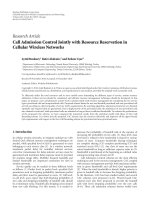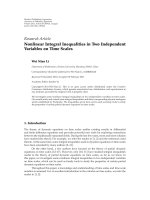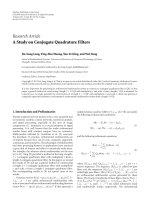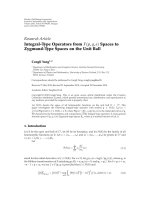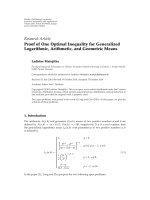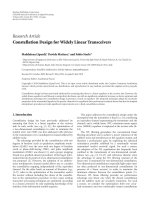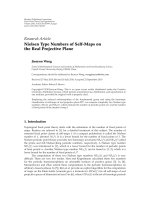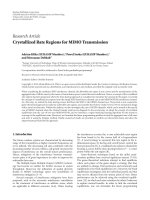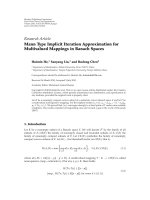báo cáo hóa học:" Research Article Jensen Type Inequalities Involving Homogeneous Polynomials" doc
Bạn đang xem bản rút gọn của tài liệu. Xem và tải ngay bản đầy đủ của tài liệu tại đây (587.78 KB, 21 trang )
Hindawi Publishing Corporation
Journal of Inequalities and Applications
Volume 2010, Article ID 850215, 21 pages
doi:10.1155/2010/850215
Research Article
Jensen Type Inequalities Involving
Homogeneous Polynomials
Jia-Jin Wen
1
and Zhi-Hua Zhang
2
1
College of Mathematics and Information Science, Chengdu University, Sichuan 610106, China
2
Department of Mathematics, Shili Senior High School in Zixing, Chenzhou, Hunan 423400, China
Correspondence should be addressed to Jia-Jin Wen,
Received 4 November 2009; Revised 25 January 2010; Accepted 8 February 2010
Academic Editor: Soo Hak Sung
Copyright q 2010 J J. Wen and Z H. Zhang. This is an open access article distributed under
the Creative Commons Attribution License, which permits unrestricted use, distribution, and
reproduction in any medium, provided the original work is properly cited.
By means of algebraic, analytical and majorization theories, and under the proper hypotheses,
we establish several Jensen type inequalities involving γth homogeneous polynomials as follows:
m
k1
w
k
fX
k
/fI
n
≤ f
m
k1
w
k
X
γ
k
/fI
n
1/γ
,
m
k1
w
k
fX
k
/fN
n
≤ f
m
k1
w
k
X
γ
k
/
fN
n
1/γ
,and
m
k1
w
k
f
∗
X
k
≤ f
∗
m
k1
w
k
X
k
, and display their applications.
1. Introduction
The following notation and hypotheses in 1–4 will be used throughout the paper:
x
x
1
,x
2
, ,x
n
†
,αα
1
,α
2
, ,α
n
†
,w
w
1
,w
2
, ,w
m
†
,
X
k
x
k,1
,x
k,2
, ,x
k,n
†
, N
{
0, 1, 2, ,n,
}
,n∈ N,n≥ 2,
R
−∞, ∞
, R
n
0, ∞
n
, R
n
0, ∞
n
, Ω
n
{
x ∈ R
n
| 0 ≤ x
1
≤ x
2
≤··· ≤ x
n
}
.
1.1
Also let
P
γ
x
⎧
⎨
⎩
α,σ
∈B
γ
× S
n
λ
α, σ
n
j1
x
α
j
σ
j
λ : B
γ
× S
n
→ R
⎫
⎬
⎭
\
{
0
}
,
P
γ
x
⎧
⎨
⎩
α,σ
∈B
γ
× S
n
λ
α, σ
n
j1
x
α
j
σ
j
λ : B
γ
× S
n
−→
0, ∞
⎫
⎬
⎭
\
{
0
}
,
2 Journal of Inequalities and Applications
P
γ
x
⎧
⎨
⎩
α∈B
γ
λ
α
n!
per
x
α
i
j
λ : B
γ
→ R
⎫
⎬
⎭
\
{
0
}
,
P
γ
x
⎧
⎨
⎩
α∈B
γ
λ
α
n!
per
x
α
i
j
λ : B
γ
→
0, ∞
⎫
⎬
⎭
\
{
0
}
,
1.2
where
x
α
i
j
x
α
i
j
n×n
⎡
⎢
⎢
⎢
⎢
⎢
⎢
⎣
x
α
1
1
x
α
1
2
x
α
1
3
··· x
α
1
n
x
α
2
1
x
α
2
2
x
α
2
3
··· x
α
2
n
.
.
.
.
.
.
.
.
.
.
.
.
.
.
.
x
α
n
1
x
α
n
2
x
α
n
3
··· x
α
n
n
⎤
⎥
⎥
⎥
⎥
⎥
⎥
⎦
n×n
,
1.3
B
γ
is a nonempty and finite subset of
α ∈ R
n
n
i1
α
i
γ,γ∈
0, ∞
,
1.4
and the permanent of n × n matrix A a
i,j
n×n
is given by see 2, 4
per A
σ∈S
n
n
j1
a
j,σj
;
1.5
here, the sum extends over all elements σ of the nth symmetric group S
n
.
If f ∈ P
γ
x, then f is called γth homogeneous polynomial; if f ∈ P
γ
x, then f is
called γth homogeneous symmetric polynomial see 3.
The famous Jensen inequality can be stated as follows: if f : I → R is a convex
function, then for any x ∈ I
n
we have
1
n
n
k1
f
x
k
≥ f
1
n
n
k1
x
k
.
1.6
A large number of generalizations and applications of the inequality 1.6 had been
obtained in 1 and 5–8. An interesting generalization of 1.6 was given by Chen et al., in
8:LetB
γ
⊂ N
n
and f ∈ P
γ
x.IfX
k
∈ R
n
with 1 ≤ k ≤ m and 0 ≤ X
1
≤ X
2
≤ ··· ≤ X
m
, then
we have the following Jensen type inequality:
1
m
m
k1
f
X
k
≥ f
1
m
m
k1
X
k
.
1.7
Journal of Inequalities and Applications 3
In this paper, by means of algebraic, analytical, and majorization theories, and under
the proper hypotheses, we will establish several Jensen type inequalities involving γth
homogeneous polynomials and display their applications.
2. Jensen Type Inequalities Involving Homogeneous Polynomials
In this section, we will use the following notation see 1, 4, 9:
Q
q
p
p ∈ N \
{
0
}
,q∈ N \
{
0
}
,I
n
1, 1, ,1
†
,N
n
1, 2, ,n
†
,
x
γ
x
γ
1
,x
γ
2
, ,x
γ
n
†
,φ
x
φx
1
,φx
2
, ,φx
n
†
,A
x
1
n
n
i1
x
i
,
Δx
Δx
1
, Δx
2
, ,Δx
n
†
x
1
,x
2
− x
1
,x
3
− x
2
, ,x
n
− x
n−1
†
.
2.1
2.1. A Jensen Type Inequality Involving Homogeneous Polynomials
We begin a Jensen type inequality involving homogeneous polynomials as follows.
Theorem 2.1. Let f ∈ P
γ
x.IfX
k
∈ R
n
with 1 ≤ k ≤ m and w ∈ R
m
,then
m
k1
w
k
f
X
k
f
I
n
≤
⎡
⎢
⎣
f
m
k1
w
k
X
γ
k
f
I
n
⎤
⎥
⎦
1/γ
.
2.2
The equality holds in 2.2 if there exists t ∈ 0, ∞, such that X
1
X
2
··· X
m
tI
n
.
Lemma 2.2. (H
¨
older’s inequality, see [1, 10]). Let a
i,k
∈ 0, ∞,q
i
∈ 0, ∞ with 1 ≤ i ≤ n and
1 ≤ k ≤ m.If
n
i1
q
i
≤ 1,then
1
m
m
k1
n
i1
a
q
i
i,k
≤
n
i1
1
m
m
k1
a
i,k
q
i
.
2.3
The equality in 2.3 holds if a
i,1
a
i,2
··· a
i,m
for 1 ≤ i ≤ n.
Lemma 2.3. (Power mean inequality, see [1, 10–11]). Let x ∈ R
n
,μ ∈ R
n
and
n
i1
μ
i
1.If
γ ∈ 1, ∞,then
n
i1
μ
i
x
γ
i
≥
n
i1
μ
i
x
i
γ
.
2.4
The inequality is reversed for γ ∈ 0, 1. The equality in 2.4 holds if and only if γ 1,or
x
1
x
2
··· x
n
.
4 Journal of Inequalities and Applications
Lemma 2.4. Let gx, α
n
j1
x
α
j
σj
and σ ∈ S
n
.Ifα ∈B
γ
and X
k
∈ R
n
with 1 ≤ k ≤ m,then
g
m
k1
X
γ
k
,α
≥
m
k1
g
X
k
,α
γ
.
2.5
The equality in 2.5 holds if α 1, 0, ,0
†
, or there exists t ∈ 0, ∞, such that X
1
X
2
···
X
m
tI
n
.
Proof. According to α ∈B
γ
,
n
j1
α
j
/γ1 ≤ 1 and Lemmas 2.2-2.3,wegetthat
g
1
m
m
k1
X
γ
k
,α
n
j1
1
m
m
k1
x
γ
k,σ
j
α
j
⎡
⎣
n
j1
1
m
m
k1
x
γ
k,σ
j
α
j
/γ
⎤
⎦
γ
≥
⎡
⎣
1
m
m
k1
n
j1
x
α
j
k,σ
j
⎤
⎦
γ
1
m
m
k1
g
X
k
,α
γ
.
2.6
From
g
1
m
m
k1
X
γ
k
,α
1
m
γ
g
m
k1
X
γ
k
,α
,
2.7
we deduce to the inequality 2.5. Lemma 2.4 is proved.
Proof of Theorem 2.1. First of all, we assume that w I
m
. According to γ ∈ 1, ∞, fI
n
α,σ∈B
γ
×S
n
λα, σ and Lemmas 2.3-2.4 ,wefindthat
f
m
k1
X
γ
k
f
I
n
α,σ∈B
γ
×S
n
λ
α, σ
f
I
n
g
m
k1
X
γ
k
,α
≥
α,σ
∈B
γ
×S
n
λ
α, σ
f
I
n
m
k1
g
X
k
,α
γ
≥
⎡
⎣
α,σ
∈B
γ
×S
n
λ
α, σ
f
I
n
m
k1
g
X
k
,α
⎤
⎦
γ
m
k1
f
X
k
f
I
n
γ
.
2.8
That is, the inequality 2.2 holds.
Journal of Inequalities and Applications 5
Secondly, for some of w
k
with 1 ≤ k ≤ m satisfing w
k
/
1, we have the following cases.
1 If w ∈ N
m
, then the inequality 2.2 holds from the above proof.
2 If w ∈ Q
m
, then there exists N ∈ N \{0} that satisfies Nw ∈ N
m
.Bytheresult
in 1,weobtainthat
m
k1
Nw
k
f
X
k
f
I
n
≤
⎡
⎢
⎢
⎢
⎣
f
m
k1
Nw
k
X
γ
k
f
I
n
⎤
⎥
⎥
⎥
⎦
1/γ
⇐⇒
m
k1
w
k
f
X
k
f
I
n
≤
⎡
⎢
⎢
⎢
⎣
f
m
k1
w
k
X
γ
k
f
I
n
⎤
⎥
⎥
⎥
⎦
1/γ
,
2.9
which implies that inequality 2.2 is also true.
3 If w ∈ R
m
, then there exist sequences {w
i
k
}
∞
i1
, such that
w
i
k
∈ Q
1 ≤ i<∞
, lim
i →∞
w
i
k
w
k
1 ≤ k ≤ m
.
2.10
We get by the case in 2 that
m
k1
w
i
k
f
X
k
f
I
n
≤
⎡
⎢
⎣
f
m
k1
w
i
k
X
γ
k
f
I
n
⎤
⎥
⎦
1/γ
,
2.11
and taking i →∞in 2.11, we can get the inequality 2.2. T he proof of Theorem 2.1 is thus
completed.
2.2. Jensen Type Inequalities Involving Difference Substitution
Exchange the ith row and jth row in nth unit matrix E, then this matrix, written Ei, j,is
called nth exchange matrix. If E
1
, E
2
, ,E
p
are nth exchange matrixes, then the n × n matrix
D
n
E
p
E
p−1
···E
1
E
0
Δ
n
is called nth difference matrix, and the substitution x D
n
y is
difference substitution, where p ∈ N, E
0
E,and
Δ
n
⎡
⎢
⎢
⎢
⎢
⎢
⎢
⎣
10··· 0
11··· 0
.
.
.
.
.
.
.
.
.
.
.
.
11··· 1
⎤
⎥
⎥
⎥
⎥
⎥
⎥
⎦
n×n
.
2.12
6 Journal of Inequalities and Applications
Let f ∈ P
γ
x.IffD
n
y ∈ P
γ
y is true for any difference matrix D
n
, then
fx ≥ 0 for any x ∈ R
n
see 11, and the homogeneous polynomial f is called positive
semidefinite with difference substitution.
If we let
D
n
{
D
n
| D
n
be nth difference matrix
}
,
P
∗
γ
x
f
x
∈ P
γ
x
|B
γ
⊂ N
n
,f
D
n
y
∈ P
γ
y
, ∀D
n
∈D
n
,
2.13
then D
n
is a finite set and the count of elements of D
n
is |D
n
| n!, and γ ∈ N.
We have the following Jensen type inequality involving homogeneous polynomials
and difference substitution.
Theorem 2.5. Let f ∈ P
∗
γ
x.Ifw ∈ R
m
, and X
k
∈ Ω
n
with 1 ≤ k ≤ m,then
m
k1
w
k
f
X
k
f
N
n
≤
⎡
⎢
⎣
f
m
k1
w
k
X
γ
k
f
N
n
⎤
⎥
⎦
1/γ
.
2.14
The equality holds in 2.14 if there exists t ∈ 0, ∞, such that X
1
X
2
··· X
m
tI
n
, and
fI
n
0.
Lemma 2.6. (Jensen’s inequality, see [12]). For any x ∈ R
n
and γ ∈ 1, ∞, we have
n
k1
x
k
γ
≥
n
k1
x
γ
k
.
2.15
The equality in 2.33 holds if and only if γ 1, or at least n − 1 numbers equal zero among the set
{x
1
,x
2
, ,x
n
}.
Lemma 2.7. If γ ∈ 1, ∞ and x ∈ Ω
n
, then for the difference substitution x Δ
n
y, one has the
following double inequality:
0 ≤ y
γ
≤ Δx
γ
. 2.16
The equality y
γ
Δx
γ
holds if and only if γ 1,orx
1
x
2
··· x
n−1
0,orx
1
x
2
··· x
n
.
Proof. From x ∈ Ω
n
, it is easy to know that y Δ
−1
n
x Δx ∈ R
n
.Byγ ∈ 1, ∞ and Lemma 2.6,
we find that
0 ≤ y
γ
1
x
γ
1
≤ x
γ
1
,
0 ≤ y
γ
2
x
2
− x
1
γ
≤ x
γ
2
− x
γ
1
,
.
.
.
0 ≤ y
γ
n
x
n
− x
n−1
γ
≤ x
γ
n
− x
γ
n−1
.
2.17
This shows that the double inequality 2.16 holds.
Journal of Inequalities and Applications 7
Proof of Theorem 2.5. Consider the difference substitution X
k
Δ
n
Y
k
. Since X
k
∈ Ω
n
, Y
k
Δ
−1
n
X
k
ΔX
k
∈ R
n
with 1 ≤ k ≤ m.Fromf ∈ P
∗
γ
x, we have that fD
n
y ∈ P
γ
y, for all
D
n
∈D
n
. Hence,
f
Δ
n
y
∈ P
γ
y
.
2.18
According to Theorem 2.1,weobtainthat
m
k1
w
k
f
Δ
n
Y
k
f
Δ
n
I
n
≤
⎡
⎢
⎣
f
Δ
n
m
k1
w
k
Y
γ
k
f
Δ
n
I
n
⎤
⎥
⎦
1/γ
⎡
⎢
⎣
f
m
k1
w
k
Δ
n
Y
γ
k
f
N
n
⎤
⎥
⎦
1/γ
.
2.19
In view of Y
k
∈ R
n
and with Lemma 2.7, we have
0 ≤ Y
γ
k
≤ ΔX
γ
k
,k 1, 2, ,m.
2.20
By noting that fΔ
n
y ∈ P
γ
y, it implies that f
m
k1
w
k
Δ
n
Y
γ
k
is increasing with
respect to Y
γ
k
.Thus,
f
m
k1
w
k
Δ
n
Y
γ
k
≤ f
m
k1
w
k
Δ
n
ΔX
γ
k
f
m
k1
w
k
X
γ
k
.
2.21
Therefore,
m
k1
w
k
f
X
k
f
N
n
m
k1
w
k
f
Δ
n
Y
k
f
Δ
n
I
n
≤
⎡
⎢
⎣
f
m
k1
w
k
Δ
n
Y
γ
k
f
N
n
⎤
⎥
⎦
1/γ
≤
⎡
⎢
⎣
f
m
k1
w
k
X
γ
k
f
N
n
⎤
⎥
⎦
1/γ
.
2.22
This evidently completes the proof of Theorem 2.5.
As an application of Theorem 2.5, we have the following.
Theorem 2.8. Let fxAx
γ
− A
γ
x,γ ∈ N and γ ≥ 2. If w ∈ R
m
,X
k
∈ Ω
n
with 1 ≤ k ≤ m,
then the inequality 2.14 holds. The equality holds in 2.14 if there exists t ∈ 0, ∞, such that
X
1
X
2
··· X
m
tI
n
.
8 Journal of Inequalities and Applications
Proof. First of all, we prove that f ∈ P
∗
γ
x. If the function φ : I → R satisfies the condition
that φ
: I → R is continuous, then we have the following identity:
A
φ
x
− φ
A
x
1
n
2
1≤i<j≤n
∇
φ
t
1
x
i
t
2
x
j
1 − t
1
− t
2
A
x
dt
1
dt
2
x
i
− x
j
2
,
2.23
where
x ∈ I
n
,φ
t
d
2
φ
dt
2
, ∇
t
1
,t
2
†
∈ R
2
| t
1
t
2
≤ 1
.
2.24
In fact,
∇
φ
t
1
x
i
t
2
x
j
1 − t
1
− t
2
A
x
dt
1
dt
2
1
0
dt
1
1−t
1
0
φ
t
1
x
i
t
2
x
j
1 − t
1
− t
2
A
x
dt
2
1
x
j
− A
x
1
0
dt
1
1−t
1
0
φ
t
1
x
i
t
2
x
j
1 − t
1
− t
2
A
x
d
t
1
x
i
t
2
x
j
1 − t
1
− t
2
A
x
1
x
j
− A
x
1
0
dt
1
φ
t
1
x
i
t
2
x
j
1 − t
1
− t
2
A
x
1−t
1
0
1
x
j
− A
x
1
0
φ
t
1
x
i
1 − t
1
x
j
− φ
t
1
x
i
1 − t
1
A
x
dt
1
1
x
j
− A
x
φt
1
x
i
1 − t
1
x
j
x
i
− x
j
−
φt
1
x
i
1 − t
1
Ax
x
i
− Ax
1
0
1
x
j
− A
x
φ
x
i
− φ
x
j
x
i
− x
j
−
φ
x
i
− φ
A
x
x
i
− A
x
1
x
i
− x
j
x
j
− A
x
x
i
− A
x
φ
A
x
A
x
1
φ
x
i
x
i
1
φ
x
j
x
j
1
,
2.25
and
1≤i<j≤n
∇
φ
t
1
x
i
t
2
x
j
1 − t
1
− t
2
A
x
dt
1
dt
2
x
i
− x
j
2
1≤i<j≤n
x
i
− x
j
x
j
− A
x
x
i
− A
x
φ
A
x
A
x
1
φ
x
i
x
i
1
φ
x
j
x
j
1
Journal of Inequalities and Applications 9
1
2
1≤i,j≤n
1
x
j
− A
x
−
1
x
i
− A
x
φ
A
x
A
x
1
φ
x
i
x
i
1
φ
x
j
x
j
1
1
2
⎛
⎜
⎜
⎝
1≤i,j≤n
1
x
j
− A
x
φ
A
x
A
x
1
φ
x
i
x
i
1
φ
x
j
x
j
1
−
1≤i,j≤n
1
x
i
− A
x
φ
A
x
A
x
1
φ
x
i
x
i
1
φ
x
j
x
j
1
⎞
⎟
⎟
⎠
1
2
⎛
⎜
⎜
⎝
n
j1
1
x
j
− A
x
n
i1
φ
A
x
A
x
1
φ
x
i
x
i
1
φ
x
j
x
j
1
−
n
i1
1
x
i
− A
x
n
j1
φ
A
x
A
x
1
φ
x
i
x
i
1
φ
x
j
x
j
1
⎞
⎟
⎟
⎠
1
2
⎛
⎜
⎜
⎜
⎜
⎜
⎝
n
j1
n
x
j
− A
x
φ
A
x
A
x
1
1
n
n
i1
φ
x
i
A
x
1
φ
x
j
x
j
1
−
n
i1
n
x
i
− A
x
φ
A
x
A
x
1
φ
x
i
x
i
1
1
n
n
j1
φ
x
j
A
x
1
⎞
⎟
⎟
⎟
⎟
⎟
⎠
1
2
⎛
⎜
⎜
⎜
⎜
⎜
⎜
⎝
n
j1
n
x
j
− A
x
φ
A
x
−
1
n
n
i1
φ
x
i
00
1
n
n
i1
φ
x
i
A
x
1
φ
x
j
x
j
1
−
n
i1
n
x
i
− A
x
φ
A
x
A
x
1
φ
x
i
x
i
1
1
n
n
j1
φ
x
j
− φ
A
x
00
⎞
⎟
⎟
⎟
⎟
⎟
⎠
n
2
⎧
⎨
⎩
n
j1
−
A
φ
x
− φ
A
x
A
x
− x
j
x
j
− A
x
−
n
i1
A
φ
x
− φ
A
x
A
x
− x
i
x
i
− A
x
⎫
⎬
⎭
n
2
⎧
⎨
⎩
n
j1
A
φ
x
− φ
A
x
n
i1
A
φ
x
− φ
A
x
⎫
⎬
⎭
n
2
A
φ
x
− φ
A
x
.
2.26
That is, the identity 2.23 holds.
10 Journal of Inequalities and Applications
Setting
φ :
0, ∞
−→ R,φ
t
t
γ
2.27
in 2.23, we have that
f
x
1
n
2
1≤i<j≤n
∇
γ
γ − 1
t
1
x
i
t
2
x
j
1 − t
1
− t
2
Ax
γ−2
dt
1
dt
2
x
i
− x
j
2
.
2.28
Since f ∈
P
γ
x, f ∈ P
∗
γ
x if and only if fΔ
n
y ∈ P
γ
y. Consider the difference
substitution x Δ
n
y.From
x
i
− x
j
2
j
ki1
y
k
2
∈ P
2
y
⇒
x
i
− x
j
2
∈ P
∗
2
x
2.29
for arbitrary i, j :1≤ i<j≤ n,itiseasytoseethatf ∈ P
∗
2
x if γ 2. If γ ≥ 3, then
x
i
− x
j
2
∈ P
∗
2
x
,
t
1
x
i
t
2
x
j
1 − t
1
− t
2
Ax
γ−2
∈ P
γ−2
x
⇒
∇
γ
γ − 1
t
1
x
i
t
2
x
j
1 − t
1
− t
2
Ax
γ−2
dt
1
dt
2
∈ P
γ−2
x
⇒
∇
γ
γ − 1
t
1
x
i
t
2
x
j
1 − t
1
− t
2
Ax
γ−2
dt
1
dt
2
∈ P
∗
γ−2
x
2.30
for arbitrary i, j :1≤ i<j≤ n. Therefore, we get that f ∈ P
∗
γ
x. It follows that the inequality
2.14 holds by using Theorem 2.5. Since fI
n
0, the equality holds in 2.14 if there exists
t ∈ 0, ∞, such that X
1
X
2
··· X
m
tI
n
.
The proof of Theorem 2.8 is thus completed.
Remark 2.9. Theorem 2.8 has significance in the theory of matrices. Let A a
i,j
n×n
be an
n × n positive definite Hermitian matrix and λ
1
, ,λ
n
its eigenvalues, let diagx be the
diagonal matrix with the components of x x
1
,x
2
, ,x
n
†
as its diagonal elements, and
also let λ λ
1
,λ
2
, ,λ
n
†
. Then A U diagλU
∗
for some unitary matrix U where U
∗
is
the conjugate transpose of U and U
∗
U E, see 9, 13.Ifγ ∈ R, then
A
γ
U diag
λ
γ
U
∗
,
tr A
n
i1
a
i,i
n
i1
λ
i
, tr A
γ
n
i1
λ
γ
i
.
2.31
Journal of Inequalities and Applications 11
Write
D
γ
A
1
n
tr A
γ
−
1
n
tr A
γ
A
λ
γ
− A
γ
λ
f
λ
,
2.32
then Theorem 2.8 can be rewritten as follows, let w ∈ R
m
,γ ∈ N and γ ≥ 2. If A
k
are n × n
positive definite Hermitian matrix, λ
A
k
∈ Ω
n
, A
i
A
j
A
j
A
i
with 1 ≤ i, j, k ≤ n, then
m
k1
w
k
D
γ
A
k
D
γ
diag
N
n
≤
⎡
⎢
⎣
D
γ
m
k1
w
k
A
γ
k
D
γ
diagN
n
⎤
⎥
⎦
1/γ
.
2.33
In fact, if A, B are n × n positive definite Hermitian matrix and AB BA, there exists a
unitary matrix U such that see 13
A U diag
λ
A
U
∗
, B U diag
λ
B
U
∗
. 2.34
Thus,
D
γ
A B
D
γ
U diag
λ
A
λ
B
U
∗
D
γ
diag
λ
A
λ
B
f
λ
A
λ
B
. 2.35
From A
i
A
j
A
j
A
i
with 1 ≤ i, j ≤ n,wegetthat
D
γ
A
k
f
λ
A
k
,D
γ
m
k1
w
k
A
γ
k
f
m
k1
w
k
λ
γ
A
k
,D
γ
diag
N
n
f
N
n
.
2.36
According to Theorem 2.8, the inequality 2.33 holds.
Remark 2.10. Theorem 2.8 has also significance in statistics. By using the same proving
method of Theorems 2.1–2.8, we can prove the following: under the hypotheses of the
Theorem 2.8,iffxAx
γ
,p − A
γ
x, p, then f ∈ P
∗
γ
x and the inequality 2.14 also
holds, where
p ∈ R
n
,A
x, p
n
i1
p
i
x
i
,
n
i1
p
i
1.
2.37
Let ξ be a random variable, x ∈ Ω
n
, let Pξ x
i
p
i
be the probability of random events
ξ x
i
with 1 ≤ i ≤ n.Ifγ 2, then
D
γ
ξ
2
γ
γ − 1
{
E
ξ
γ
− E
γ
ξ
}
2
γ
γ − 1
A
x
γ
,p
− A
γ
x, p
D
γ
x, p
2.38
12 Journal of Inequalities and Applications
is the variance of random variable ξ.TheD
γ
ξ is called γth variance of random variable ξ
and D
γ
ξ ≥ 0 for arbitrary γ ∈ R, where
D
0
ξ
lim
γ → 0
D
γ
ξ
2
log A
x, p
− A
log x, p
,
D
1
ξ
lim
γ → 1
D
γ
ξ
2
A
x log x,p
− A
x, p
log A
x, p
.
2.39
Let ξ
0
be also a random variable, Pξ
0
ip
i
with 1 ≤ i ≤ n, and let the function f
k
:
0, ∞ → 0, ∞ be increasing with 1 ≤ k ≤ m. Then the inequality 2.14 can be rewritten as
follows:
m
k1
w
k
D
γ
f
k
ξ
D
γ
ξ
0
≤
⎧
⎨
⎩
D
γ
m
k1
w
k
f
γ
k
ξ
D
γ
ξ
0
⎫
⎬
⎭
1/γ
,
2.40
where w ∈ R
m
,γ ∈ N, γ ≥ 2.
2.3. Applications of Jensen Type Inequalities
By 1.7 and the same proving method of Theorem 2.1, we can obtain the following result.
Corollary 2.11. Let B
γ
⊂ N
n
,f ∈ P
γ
x.Ifw ∈ R
m
,
m
k1
w
k
1,X
k
∈ R
n
with 1 ≤ k ≤ m and
0 ≤ X
1
≤ X
2
≤··· ≤ X
m
,then
m
k1
w
k
f
X
k
≥ f
m
k1
w
k
X
k
.
2.41
One gives several integral analogues of 2.2 and 2.41 as follows.
Corollary 2.12. Let E be bounded closed region in R
s
, and let the functions w : E → 0, ∞ and
g : E → R
n
be continuous, and
E
wdt 1.Iff ∈ P
γ
x and fI
n
1,then
E
wf
g
dt ≤
f
E
wg
γ
dt
1/γ
.
2.42
If B
γ
⊂ N
n
,f ∈ P
γ
x, and gE is an ordered set, that is,
g
t
1
≤ g
t
2
or g
t
2
≤ g
t
1
2.43
Journal of Inequalities and Applications 13
for arbitrary t
1
,t
2
: t
1
∈ E and t
2
∈ E,then
E
wf
g
dt ≥ f
E
wg dt
.
2.44
As an application of the proof of Theorem 2.8, one has the following.
Corollary 2.13. Let w ∈ R
m
and
m
k1
w
k
1,p ∈ R
n
and
n
k1
p
k
1,γ ∈ 1, 2. If X
k
∈ R
n
,
with 1 ≤ k ≤ m, then one has the following Jensen type inequality:
m
k1
w
k
D
γ
X
k
,p
≥ D
γ
m
k1
w
k
X
k
,p
,
2.45
where D
γ
x, p2/γγ − 1Ax
γ
,p − A
γ
x, p.
Proof. We can suppose that p 1/nI
n
,γ ∈ 1, 2,and
ω
i,j
x, t
1
,t
2
t
1
x
i
t
2
x
j
1 − t
1
− t
2
A
x
. 2.46
Since 0 < 2 − γ<1, from Lemma 2.3,wegetthat
m
k1
w
k
ω
i,j
X
k
,t
1
,t
2
γ−2
m
k1
w
k
|x
k,i
− x
k,j
|
2
≤
m
k1
w
k
ω
2−γ
i,j
X
k
,t
1
,t
2
−1
m
k1
w
k
|x
k,i
− x
k,j
|
2
m
k1
w
k
ω
2−γ
i,j
X
k
,t
1
,t
2
⎛
⎝
m
k1
w
k
ω
2−γ
i,j
X
k
,t
1
,t
2
ω
γ−2
i,j
X
k
,t
1
,t
2
|x
k,i
− x
k,j
|
m
k1
w
k
ω
2−γ
i,j
X
k
,t
1
,t
2
⎞
⎠
2
≤
m
k1
w
k
ω
2−γ
i,j
X
k
,t
1
,t
2
m
k1
w
k
ω
2−γ
i,j
X
k
,t
1
,t
2
ω
2γ−4
i,j
X
k
,t
1
,t
2
|x
k,i
− x
k,j
|
2
m
k1
w
k
ω
2−γ
i,j
X
k
,t
1
,t
2
m
k1
w
k
ω
γ−2
i,j
X
k
,t
1
,t
2
|x
k,i
− x
k,j
|
2
.
2.47
By using 2.28,wefindthat
14 Journal of Inequalities and Applications
D
γ
m
k1
w
k
X
k
,p
2
n
2
1≤i<j≤n
⎧
⎨
⎩
∇
ω
i,j
m
k1
w
k
X
k
,t
1
,t
2
γ−2
dt
1
dt
2
⎫
⎬
⎭
m
k1
w
k
x
k,i
− x
k,j
2
≤
2
n
2
1≤i<j≤n
⎧
⎨
⎩
∇
ω
i,j
m
k1
w
k
X
k
,t
1
,t
2
γ−2
dt
1
dt
2
⎫
⎬
⎭
m
k1
w
k
|x
k,i
− x
k,j
|
2
2
n
2
1≤i<j≤n
⎧
⎨
⎩
∇
ω
i,j
m
k1
w
k
X
k
,t
1
,t
2
γ−2
m
k
w
k
|x
k,i
− x
k,j
|
2
dt
1
dt
2
⎫
⎬
⎭
2
n
2
1≤i<j≤n
⎧
⎨
⎩
∇
m
k1
w
k
ω
i,j
X
k
,t
1
,t
2
γ−2
m
k1
w
k
|x
k,i
− x
k,j
|
2
dt
1
dt
2
⎫
⎬
⎭
≤
2
n
2
1≤i<j≤n
∇
m
k1
w
k
ω
γ−2
i,j
X
k
,t
1
,t
2
|x
k,i
− x
k,j
|
2
dt
1
dt
2
m
k1
w
k
⎧
⎨
⎩
2
n
2
1≤i<j≤n
∇
ω
γ−2
i,j
X
k
,t
1
,t
2
dt
1
dt
2
x
k,i
− x
k,j
2
⎫
⎬
⎭
m
k1
w
k
D
γ
X
k
,p
.
2.48
The proof of Corollary 2.13 is thus completed.
Corollary 2.14. If X
k
∈ Ω
n
with 1 ≤ k ≤ m,then
m
k1
n
n − 1
/2
det
X
k
i−1
j
n×n
≤
n
n−1
/2
det
⎡
⎣
m
k1
X
k
i−1
j
⎤
⎦
n×n
.
2.49
Proof. The nth Vandermonde determinant is wellknown see 14:
det
x
i−1
j
n×n
1≤i<j≤n
x
j
− x
i
.
2.50
By Theorem 2.1, for arbitrary x
k,i,j
∈ 0, ∞ with 1 ≤ i<j≤ n, 1 ≤ k ≤ m,wegetthat
m
k1
1≤i<j≤n
x
k,i,j
≤
n
n−1
/2
1≤i<j≤n
m
k1
x
nn−1/2
k,i,j
.
2.51
Journal of Inequalities and Applications 15
Letting
w I
m
,x
k,i,j
n
n−1
/2
x
k,j
− x
k,i
, 1 ≤ i<j≤ n, 1 ≤ k ≤ m 2.52
in inequality 2.51, it implies that the inequality 2.49 holds. The proof is completed.
Example 2.15. Given N-inscribed-polygon Γ
k
Γ
k
A
k,1
,A
k,2
, ,A
k,N
with 1 ≤ k ≤ m.
Defining the summation of them is an N-inscribed-polygon Γ
m
k1
Γ
k
ΓA
1
,A
2
, ,A
N
,
and its sides lengths are given by |A
i
A
i1
|
m
k1
|A
k,i
A
k,i1
| with 1 ≤ i ≤ N. Also defining
A
i
A
j
⇔ i ≡ jmodN,andA
k,i
A
k,j
⇔ i ≡ jmodN with 1 ≤ k ≤ m.
Wen and Zhang in 15 raised a conjecture: prove that
m
k1
Γ
k
≥
m
k1
|
Γ
k
|
,
2.53
where |Γ| Area Γ is the area of the N-inscribed-polygon Γ.
Now, we prove that the inequality 2.53 holds for N 3, 4byusingTheorem 2.1.
Denote
a
k,i
|
A
k,i
A
k,i1
|
,p
k
1
2
N
i1
a
k,i
,a
i
|
A
i
A
i1
|
m
k1
a
k,i
,
p
1
2
N
i1
a
i
m
k1
p
k
, 1 ≤ i ≤ N, 1 ≤ k ≤ m.
2.54
If N 3, we have that
|
Γ
k
|
4
p
k
3
i1
p
k
− a
k,i
,
m
k1
Γ
k
4
m
k1
p
k
3
i1
m
k1
p
k
− a
k,i
.
2.55
Setting
f ∈ P
4
x
,f
x
4
i1
x
i
,n 4,
w I
m
,x
k,1
4
p
k
,x
k,i
4
p
k
− a
k,i
, 2 ≤ i ≤ 4, 1 ≤ k ≤ m
2.56
in Theorem 2.1, then inequality 2.2 is just 2.53.
16 Journal of Inequalities and Applications
For N 4, we get that
|
Γ
k
|
4
4
i1
p
k
− a
k,i
,
m
k1
Γ
k
4
4
i1
m
k1
p
k
− a
k,i
.
2.57
Taking
f ∈ P
4
x
,f
x
4
i1
x
i
,n 4,
w I
m
,x
k,i
4
p
k
− a
k,i
, 1 ≤ i ≤ 4, 1 ≤ k ≤ m
2.58
in Theorem 2.1, it is clear to see that inequality 2.2 deduces to 2.53.
Remark 2.16. The following result was obtained in 15.LetΓ
k
with 1 ≤ k ≤ m and
m
k1
Γ
k
all be N-inscribed-polygons. If p
1
− a
1,i
≤ p
2
− a
2,i
≤ ··· ≤ p
m
− a
m,i
,i 1, 2, ,N, then for
N 3, 4, we have
m
k1
Γ
k
2
≤ m
3
m
k1
|
Γ
k
|
2
.
2.59
This inequality can also be deduced from inequality 1.7.
3. Jensen Type Inequalities Involving Homogeneous
Symmetric Polynomials
In this section, we will also use the following notation see 4, 16:
e
x
e
x
1
,e
x
2
, ,e
x
n
†
, Ω
n
∗
{
x ∈ R
n
| x
1
≤ x
2
≤··· ≤ x
n
}
,
α
l
α
l
1
,α
l
2
, ,α
l
n
†
∈B
γ
,p max
1≤l≤N
α
l
1
,α
l
2
, ,α
l
n
,
m
k1
X
k
m
k1
x
k,1
,
m
k1
x
k,2
, ,
m
k1
x
k,n
†
,
X
1
X
2
x
1,1
x
2,1
,
x
1,2
x
2,2
, ,
x
1,n
x
2,n
†
.
3.1
Journal of Inequalities and Applications 17
Definition 3.1. see 17, 18. B
γ
is called the control ordered set if
α ≺ β or β ≺ α 3.2
for arbitrary α, β : α ∈B
γ
and β ∈B
γ
.
The well-known Chebyshev inequality states: let a, b ∈ R
m
, w ∈ R
m
,
and
m
k1
w
k
1.
If a
1
≤ a
2
≤··· ≤ a
m
and b
1
≤ b
2
≤··· ≤ b
m
, then
m
k1
w
k
a
k
b
k
≥
m
k1
w
k
a
k
×
m
k1
w
k
b
k
.
3.3
The inequality is reversed for b
1
≥ b
2
≥··· ≥ b
m
.
We remark here that Wen and Wang generalized the inequality 3.3 in 4:ifX
1
,X
2
∈
Ω
n
,andα ∈ R
n
, then we have the following Chebyshev type inequality:
per
X
1
X
2
α
i
j
n!
≥
per
X
1
α
i
j
n!
×
per
X
2
α
i
j
n!
.
3.4
3.1. Jensen Type Inequalities Involving Homogeneous Symmetric Polynomials
In this subsection, we first present a J ensen type inequality involving homogeneous symmet-
ric polynomials as follows.
Theorem 3.2. Let f ∈
P
γ
x,fI
n
1,w ∈ N
m
, let B
γ
be a control ordered set. If X
k
∈ Ω
n
∗
with
1 ≤ k ≤ m,then
m
k1
w
k
f
∗
X
k
≤ f
∗
m
k1
w
k
X
k
,
3.5
where f
∗
: R
n
→ R,f
∗
xlog fe
x
.
Proof. By using the same proving method of Theorem 2.1, we can suppose that w I
m
.If
m 1, then inequality 3.5 holds. So we just need to prove the following.
Let f ∈
P
γ
x,fI
n
1beB
γ
is a control ordered set. If X
k
∈ Ω
n
with 1 ≤ k ≤ m and
m ≥ 2, then
f
m
k1
X
k
≥
m
k1
f
X
k
.
3.6
We will verify inequality 3.6 by induction.
For m 2, we find from the inequality 3.4 that
f
X
1
X
2
α∈B
γ
λ
α
n!
per
X
1
X
2
α
i
j
n×n
≥
α∈B
γ
λ
α
per
X
1
α
i
j
n!
×
per
X
2
α
i
j
n!
.
3.7
18 Journal of Inequalities and Applications
Since the control ordered set B
γ
is nonempty and finite set by using Definition 3.1,we
can suppose that
B
γ
α
1
,α
2
, ,α
N
,α
1
≺ α
2
≺··· ≺ α
N
. 3.8
From Hardy’s inequality see 17, page 74, we have that
per
X
1
α
1
i
j
n!
≤
per
X
1
α
2
i
j
n!
≤··· ≤
per
X
1
α
N
i
j
n!
,
per
X
2
α
1
i
j
n!
≤
per
X
2
α
2
i
j
n!
≤··· ≤
per
X
2
α
N
i
j
n!
.
3.9
By means of fI
n
N
l1
λα
l
1, inequality 3.7, and Chebyshev’s inequality
3.3,itiseasytoobtainthat
f
X
1
X
2
≥
N
l1
λ
α
l
per
X
1
α
l
i
j
n!
×
per
X
2
α
l
i
j
n!
≥
⎛
⎜
⎜
⎝
N
l1
λ
α
l
per
X
1
α
l
i
j
n!
⎞
⎟
⎟
⎠
×
⎛
⎜
⎜
⎝
N
l1
λ
α
l
per
X
2
α
l
i
j
n!
⎞
⎟
⎟
⎠
f
X
1
f
X
2
,
3.10
which implies that the inequality 3.6 holds for m 2.
Assume that the inequality 3.6 is true for m q ≥ 2, that is,
f
q
k1
X
k
≥
q
k1
f
X
k
.
3.11
For m q 1, from X
q1
∈ Ω
n
and X
1
,X
2
, ,X
q
∈ Ω
n
, we have
q
k1
X
k
∈ Ω
n
. Thus,
f
q1
k1
X
k
f
X
q1
q
k1
X
k
≥ f
X
q1
f
q
k1
X
k
≥ f
X
q1
q
k1
f
X
k
q1
k1
f
X
k
.
3.12
The inequality 3.6 is proved by induction. The proof of Theorem 3.2 is hence completed.
As an application of the inequality 3.6, we have the following.
Journal of Inequalities and Applications 19
Theorem 3.3. Let f ∈
P
γ
x,letB
γ
be a control ordered set, that is,
B
γ
α
1
,α
2
, ,α
N
,α
1
≺ α
2
≺··· ≺ α
N
. 3.13
If X
1
/X
2
∈ Ω
n
,X
2
∈ Ω
n
, and X
2
∈ R
n
, then
1
n!
per
⎡
⎣
X
1
X
2
α
1
i
j
⎤
⎦
≤
f
X
1
f
X
2
≤
n
i1
x
p
1,i
n
i1
x
p
2,i
γ/p
.
3.14
Proof. The right-hand inequality of 3.14 is proved in 4. Now, we will give the
demonstration of the left-hand inequality in 3.14.
We can suppose that fI
n
1. By means of X
1
/X
2
∈ Ω
n
, X
2
∈ Ω
n
,andX
2
∈ R
n
,we
find from the inequality 3.6 that
f
X
1
X
2
X
2
≥ f
X
1
X
2
f
X
2
⇐⇒
f
X
1
f
X
2
≥ f
X
1
X
2
.
3.15
From
B
γ
α
1
,α
2
, ,α
N
,α
1
≺ α
2
≺··· ≺ α
N
3.16
and Hardy’s inequality see 17, page 74,weobtainthat
per
X
1
X
2
α
i
j
≥ per
⎡
⎣
X
1
X
2
α
1
i
j
⎤
⎦
, ∀α ∈B
γ
. 3.17
Therefore, we deduce that
f
X
1
f
X
2
≥ f
X
1
X
2
α∈B
γ
λ
α
n!
per
X
1
X
2
α
i
j
n×n
≥
α∈B
γ
λ
α
n!
per
⎡
⎣
X
1
X
2
α
1
i
j
⎤
⎦
n×n
1
n!
per
⎡
⎣
X
1
X
2
α
1
i
j
⎤
⎦
n×n
f
I
n
1
n!
per
⎡
⎣
X
1
X
2
α
1
i
j
⎤
⎦
n×n
.
3.18
The proof of Theorem 3.3 is thus completed.
20 Journal of Inequalities and Applications
3.2. Remarks
Remark 3.4. If γ ∈0, ∞, then Theorems 3.2 and 3.3 are also true.
Remark 3.5. If B
γ
⊂ N
n
and 1 ≤ γ ≤ 5, then B
γ
is a control ordered set.
In fact,
1, 0, ,0
†
≺ 1, 0, ,0
†
;
1, 1, 0, ,0
†
≺ 2, 0, ,0
†
;
1, 1, 1, 0, ,0
†
≺ 2, 1, 0, ,0
†
≺ 3, 0, ,0
†
;
1, 1, 1, 1, 0, ,0
†
≺ 2, 1, 1, 0, ,0
†
≺ 2, 2, 0, ,0
†
≺ 3, 1, 0, ,0
†
≺ 4, 0, ,0
†
;
1, 1, 1, 1, 1, 0, ,0
†
≺ 2, 1, 1, 1, 0, ,0
†
≺ 2, 2, 1, 0, ,0
†
≺ 3, 1, 1, 0, ,0
†
≺ 3, 2, 0, ,0
†
≺ 4, 1, 0, ,0
†
≺ 5, 0, ,0
†
.
3.19
Remark 3.6. By using the proof of Theorem 3.2 and Remark 3.5, we know the following: if
X
k
∈ Ω
n
with 1 ≤ k ≤ m, m ≥ 2and
f
x
1
n
γ
− n
n
k1
x
k
γ
−
n
k1
x
γ
k
,γ∈ N, 1 <γ≤ 5,
3.20
then the inequality 3.6 holds.
Remark 3.7. The inequality 3.6 is also a Chebyshev type inequality involving homogeneous
symmetric polynomials.
3.3. An Open Problem
According to Theorem 3.3, we pose the following open problem.
Conjecture 3.8. Under the hypotheses of Theorem 3.3, one has
1
n!
per
⎡
⎣
X
1
X
2
α
1
i
j
⎤
⎦
≤
per
X
1
α
1
i
j
per
X
2
α
1
i
j
≤
f
X
1
f
X
2
≤
n
i1
x
p
1,i
n
i1
x
p
2,i
γ/p
. 3.21
Journal of Inequalities and Applications 21
References
1 P. S. Bullen, P. S. Mitrinovi
´
c,andP.M.Vasi
´
c, Means and Their Inequalities, Reidel, Dordrecht, The
Netherlands, 1988.
2 H. Minc, Permanents, vol. 9999 of Encyclopedia of Mathematics and Its Applications, Addison-Wesley,
Reading, Mass, USA, 1978.
3 V. Timofte, “On the positivity of symmetric polynomial functions. I. General results,” Journal of
Mathematical Analysis and Applications, vol. 284, no. 1, pp. 174–190, 2003.
4 J J. Wen and W L. Wang, “Chebyshev type inequalities involving permanents and their applica-
tions,” Linear Algebra and Its Applications, vol. 422, no. 1, pp. 295–303, 2007.
5 J. Pe
ˇ
cari
´
c and D. Svrtan, “New refinements of the Jensen inequalities based on samples with
repetitions,” Journal of Mathematical Analysis and Applications, vol. 222, no. 2, pp. 365–373, 1998.
6 Z G. Xiao, H. M. Srivastava, and Z H. Zhang, “Further refinements of the Jensen inequalities based
upon samples with repetitions,” Mathematical and Computer Modelling, vol. 51, no. 5-6, pp. 592–600,
2010.
7 C. Gao and J. Wen, “Inequalities of Jensen-Pe
ˇ
cari
´
c-Svrtan-Fan type,” Journal of Inequalities in Pure and
Applied Mathematics, vol. 9, no. 3, article 74, 8 pages, 2008.
8 Y X. Chen, J Y. Luo, and J K. Yang, “A class of Jensen inequalities for homogeneous and symmetric
polynomials,” Journal of Sichuan Normal University, vol. 30, pp. 481–484, 2007 Chinese.
9 J J. Wen, S. S. Cheng, and C. Gao, “Optimal sublinear inequalities involving geometric and power
means,” Mathematica Bohemica, vol. 134, no. 2, pp. 133–149, 2009.
10 J J. Wen and W L. Wang, “The optimization for the inequalities of power means,” Journal of
Inequalities and Applications, vol. 2006, Article ID 46782, 25 pages, 2006.
11 L. Yang, Y. Feng, and Y. Yao, “A class of mechanically decidable problems beyond Tarski’s model,”
Science in China. Series A, vol. 50, no. 11, pp. 1611–1620, 2007.
12 W. V. Jensen, “Sur les fonctions convexes et les in
´
egalit
´
es entre les valeurs moyennes,” Acta
Mathematica, vol. 30, no. 1, pp. 175–193, 1906.
13 B. Mond and J. E. Pe
ˇ
cari
´
c, “Generalization of a matrix inequality of Ky Fan,” Journal of Mathematical
Analysis and Applications, vol. 190, no. 1, pp. 244–247, 1995.
14 J J. Wen and W L. Wang, “Inequalities involving generalized interpolation polynomials,” Computers
& Mathematics with Applications, vol. 56, no. 4, pp. 1045–1058, 2008.
15 J J. Wen and R X. Zhang, “Two conjectured inequalities involving the sums of inscribed polygons in
some circles,” Journal of Shanxi Normal University, vol. 30, supplement 1, pp. 12–17, 2002 Chinese.
16 J. Pe
ˇ
cari
´
c, J J. Wen, W L. Wang, and T. Lu, “A generalization of Maclaurin’s inequalities and its
applications,” Mathematical Inequalities and Applications, vol. 8, no. 4, pp. 583–598, 2005.
17 B Y. Wang, An Introduction to the Theory of Majorizations, Beijing Normal University Press, Beijing,
China, 1990.
18 A. W. Marshall and I. Olkin, Inequalities: Theory of Majorization and Its Applications, vol. 143 of
Mathematics in Science and Engineering, Academic Press, New York, NY, USA, 1979.
